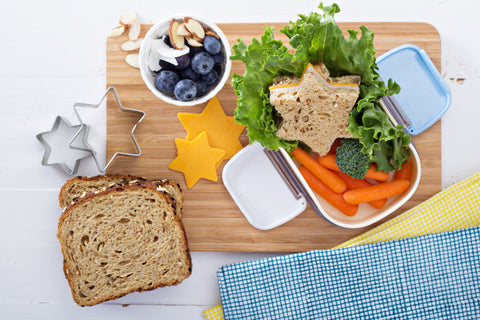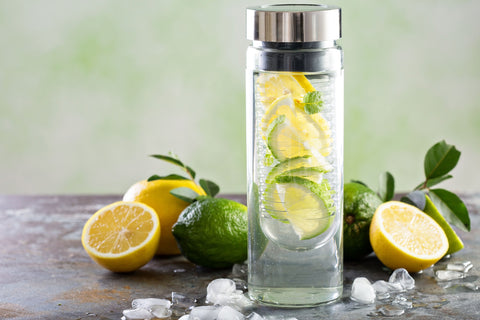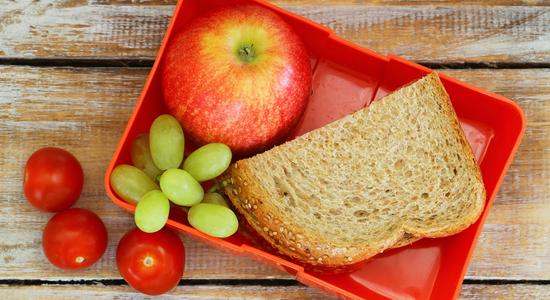Healthy lunches are important for children who need to concentrate at school. A healthy school lunch provides them with energy to get through their busy day and helps establish healthy habits.
Sometimes it’s a struggle to think of new lunchbox ideas for your children. Here at Digestive Advantage®, we have put together some back to school ideas. We’ll give you variations and a healthy balance to help reduce tummy troubles and keep everyone’s appetites healthy!
Get the balance right
Aim for a healthy, nutritional balance when packing your kids lunch. A healthy lunch includes two servings of grains, one serving of fruit, one serving of vegetables, one serving of protein and one serving of dairy[1]. However, you should consult a pediatrician/nutritionist to determine what your child should be eating. You should also consider potential allergies, of which the most common allergens include; milk, eggs, peanuts, tree nuts, soy, wheat, fish and sesame[2].
Variety is king when preparing lunch. Make sure you mix things up in terms of taste, texture and color. Test lots of different food variations with your little eaters to find what works and what doesn’t.
Make everything the night before and divide your refrigerator to include all the necessary elements that should go in a packed lunch. Get the kids involved! Allow them to pack their own lunch in the mornings. This will mean less work for you and they are more likely to enjoy eating their lunch knowing they have taken part in picking their own items.

Go safe with a sandwich
Choose wholegrain instead of refined white breads. The fiber in whole grains can support healthy digestion in a few ways. It helps give bulk to stools and helps to prevent constipation. Some types of fiber in the grains acts as prebiotics, feeding the healthy good bacteria in the gut[3].
Make it fun! Cut the sandwiches in fun shapes. There are lots of different sandwich cutters out there. Make fun shapes, create food animals and make kids enjoy what they eat.
Change this up by varying the style of bread. Choose a wholegrain wrap and roll your filling, slicing into segments. It works great with tuna or cold-cuts and cheese. Create mini stackables with crackers or pita breads. Cut the meat, cheese and vegetables in to squares and let kids enjoy creating variations of stack-ups during their lunch break.

Remember your kids 5-a-day
Getting creative with fruits and vegetables can make your kids school lunch healthy and fun.
Apples are a good source of calcium, magnesium, and potassium[4]. They are an easy way to boost the fiber content of your child’s diet and may reduce constipation[5].
To make things more exciting, why not pair the apples with a serving of peanut butter? Peanut butter contains a lot of nutritional benefits and it’s a great source of protein, fiber, vitamins and minerals[6]. Remember to only serve around 1-2 tablespoons of the nutty spread and look for a natural style product with little or no added fat or sugar5.
Carrots are best when they are fresh and crunchy. This slender and slightly sweet vegetable is packed with beta carotenes which is converted into Vitamin A by the body – a nutrient for eye health[7]. Adding hummus livens up the serving and provides a great source of plant-based protein for your child. It’s packed with healthy ingredients such as olive oil and chickpeas, that are proven to have anti-inflammatory benefits6. Most importantly, hummus is high in fiber, promoting digestive health and feeding good bacteria in the gut[8].
Bananas contain fiber and resistant starch, which may feed friendly gut bacteria and help improve digestive health. These curved, thick skinned fruit are one of the most convenient snacks around. Easy to eat and transport, there’s no reason why you shouldn’t add this easy-to-digest fruit to your child’s lunchbox[9].
Allow them to enjoy a healthy treat
Children may not be allowed to take nuts to school due to the risks of severe allergic reactions. Popcorn is a great healthy alternative to nuts and other sweet treats. Avoid the sugar-loaded, high fat and butter varieties and your kids will enjoy this delicious and healthy snack.
Sweet potatoes have a delicious sweet taste and can be incredibly nutritious, containing high amounts of fiber[10]. Prepare some homemade baked sweet potato chips for a creative and healthy alternative to deep fried chips you usually find in supermarkets.
Crispy kale is easy to cook and makes for an easy go to snack. Packed with vitamins and minerals, this snack is a great alternative to regular potato chips[11]. Add some flavor while baking with some salt and pepper and allow your kids to munch away at lunchtime.
Yogurt helps to calm digestive complaints as it contains live cultures that help lactose digestion[12]. Some types of yogurt contain probiotics, which may help with digestive health[13]. However, food is not the only way to reap the benefits of probiotics. Digestive Advantage probiotics for kids are a convenient way to add good bacteria to your child’s digestive system.

Stay hydrated throughout the day
It’s important for your child to stay hydrated as children are more susceptible to dehydration than adults. This is because they have smaller bodies, meaning they have smaller reserves of water[14].
Fruit juices can be just as unhealthy as sugary drinks. The small amounts of vitamins and antioxidants in the juice do not make up for the large amount of sugar[15]. For a healthy alternative, why not infuse their water with some fresh fruit for some added fruity flavors? You can even freeze the fruit to replace ice cubes to keep the water cold all-day long.
Don’t forget the lunch box
Soft lunch boxes can easily be folded up after lunch and put in a backpack. However, hard lunch boxes with separate compartments allow for packing a variety of food items without having to use lots of separate packaging that can be bad for the environment.
Look for an insulated lunch box to keep food fresh and make sure to include an icepack to keep the food cool.
Incorporate probiotics into your child’s diet
It’s important that your child enjoys a happy and healthy time during their school years. The last thing you want is your child having tummy troubles.
Choose from two of our 2 KIDS products to support your child’s overall digestive health.
The Digestive Advantage® KIDS Daily Probiotic Gummies can be consumed by children aged 4 – 12 and can help lessen minor abdominal discomfort and occasional bloating*.
The Digestive Advantage® KIDS Prebiotic Fiber Plus Probiotic Gummies is designed for children 4 years and older. The product includes 2 ingredients ideal to promote better digestive health. The prebiotic works naturally with probiotics and it supports the growth of healthy bacteria*.
Our kid’s gummies are made with natural flavors for a fun, great tasting format. Your child will want to take them!
References:
[1] “School Lunches” Harvard Health Publishing, Jul 2015. https://www.health.harvard.edu/childrens-health/school-lunches
[2] Clowes, Gina. “What every parent must know about managing food allergies at school”
[3] Jennings, Kerri-Ann. “9 legitimate health benefits of eating whole grains” Healthline, 23. Dec 2016. https://www.healthline.com/nutrition/9-benefits-of-whole-grains
[4] Weatherspoon, Deborah. “Will eating apples help if you have acid reflux?” Healthline, 16 May 2016. https://www.healthline.com/health/digestive-health/apples-and-acid-reflux
[5] Mandl, Elise. “The 17 best foods to relieve constipation” Healthline, 15 Apr 2018. https://www.healthline.com/nutrition/best-foods-for-constipation
[6] Magee, Elaine. “Nutty about peanut butter” WebMD, 2008. https://www.webmd.com/food-recipes/features/nutty-about-peanut-butter#1
[7] Mikstas, Christine. “Veggie Bites: Meet the carrot” WebMD, 16 May 2018. https://fit.webmd.com/kids/food/article/carrot
[8] Raman, Ryan. “Is hummus healthy? 8 great reasons to eat more hummus.” Healthline, 2 May 2018. https://www.healthline.com/nutrition/is-hummus-healthy
[9] Bjarnadottir, Adda. “11 evidence-based health benefits of bananas” Healthline, 3 Jun 2017. https://www.healthline.com/nutrition/11-proven-benefits-of-bananas
[10] Bjarnadottir, Adda. “Sweet potatoes 101: Nutrition facts and health benefits” Healthline, 6 Apr 2015. https://www.healthline.com/nutrition/foods/sweet-potatoes
[11] “Calories in Kale” My Fitness Pal, Undated. https://www.myfitnesspal.com/food/calories/kale-kale-chopped-634639460?v2=false
[12] “10 best and worst foods for your tummy” Everyday Health, 14 Nov 2017. https://www.everydayhealth.com/digestive-health/10-best-worst-foods-your-tummy/
[13] Elliot, Brianna. “7 impressive health benefits of yogurt” Healthline, 20 Jan 2017. https://www.healthline.com/nutrition/7-benefits-of-yogurt
[14] Marusinec, Laura. “The warning signs of dehydration in toddlers” Healthline, 2 Jun 2016. https://www.healthline.com/health/parenting/signs-of-dehydration-in-toddlers
[15] Gunnars, Kris. “Fruit juice is just as unhealthy as a sugary drink” Healthline, 4 Jun 2017. https://www.healthline.com/nutrition/fruit-juice-is-just-as-bad-as-soda
* THESE STATEMENTS HAVE NOT BEEN EVALUATED BY THE FOOD AND DRUG ADMINISTRATION. THESE PRODUCTS ARE NOT INTENDED TO DIAGNOSE, TREAT, CURE OR PREVENT DISEASE.
